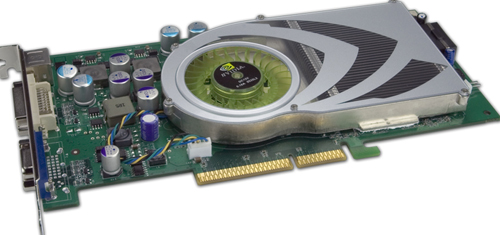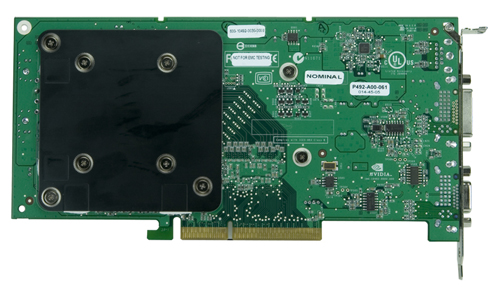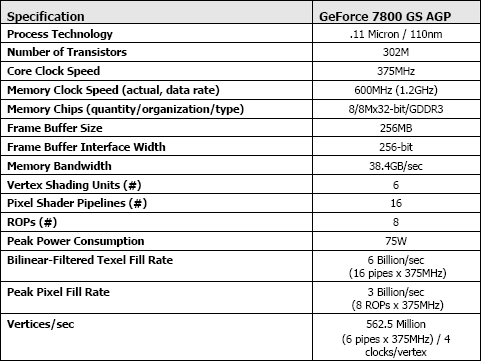The Card and The Test
As mentioned, we currently have both a 7800 GS from EVGA and the 7800 GS OC from BFG. Neither of these cards run at the default 375/1.2 clock speeds set forth by NVIDIA. For the purposes of these tests, we underclocked a card to the minimum speed that NVIDIA is endorsing. With the high clock speeds that we see from BFG and EVGA, we'd be willing to bet that even 7800 GS parts that don't come factory overclocked would have some head room. The EVGA card is clocked at core/mem clocks of 460/1.35, while the BFG part runs at 400/1.25. It is interesting to note that the BFG part makes a bigger deal out of being overclocked on the box than the EVGA card, but either way, the 7800 GS is no slouch.
Gigabyte K8U-939 ULi based motherboard
AMD Athlon 64 FX-57
2x 1GB OCZ PC4000 RAM @ 200MHz 2:3:3:8
160GB Seagate 7200.7 HD
OCZ 600W PowerStream PSU
For reference, we have included the 7800 GTX 512 and the X1900 XTX. This gives us a clear look at the highest end ATI and NVIDIA hardware available for both the AGP and PCIe platforms. The 7800 GT is also included in order to show us the performance of the next fastest NVIDIA part out there.
Here's a breakdown of the 7800 GS specifications as outlined by NVIDIA.
As mentioned, we currently have both a 7800 GS from EVGA and the 7800 GS OC from BFG. Neither of these cards run at the default 375/1.2 clock speeds set forth by NVIDIA. For the purposes of these tests, we underclocked a card to the minimum speed that NVIDIA is endorsing. With the high clock speeds that we see from BFG and EVGA, we'd be willing to bet that even 7800 GS parts that don't come factory overclocked would have some head room. The EVGA card is clocked at core/mem clocks of 460/1.35, while the BFG part runs at 400/1.25. It is interesting to note that the BFG part makes a bigger deal out of being overclocked on the box than the EVGA card, but either way, the 7800 GS is no slouch.


Gigabyte K8U-939 ULi based motherboard
AMD Athlon 64 FX-57
2x 1GB OCZ PC4000 RAM @ 200MHz 2:3:3:8
160GB Seagate 7200.7 HD
OCZ 600W PowerStream PSU
For reference, we have included the 7800 GTX 512 and the X1900 XTX. This gives us a clear look at the highest end ATI and NVIDIA hardware available for both the AGP and PCIe platforms. The 7800 GT is also included in order to show us the performance of the next fastest NVIDIA part out there.
Here's a breakdown of the 7800 GS specifications as outlined by NVIDIA.











93 Comments
View All Comments
JarredWalton - Friday, February 3, 2006 - link
The interesting thing is that AGP 6800 GS cards actually use NV40 chips, so they can unlock to 16 pipes and 6 vertex units (plus 16 ROPs) if you're somewhat lucky. They're basically like the X800 GTO in OC/unlock potential. Problem is getting software that will allow that. They *don't* OC hardly at all, in comparison to the NV42 6800 GS.If you want my opinion, this 7800 GS AGP stuff is too little too late. NVIDIA and ATI are both trying to get users to upgrade to PCIe for several reasons. First, it potentially makes them more money, since they also sell a lot of chipsets. Second, and probably more importantly, supporting older technology just makes more work for them. They would rather focus on one platform and forget about AGP. The conspiracy theorist in me says that 7800 GS was intentionally crippled just to help AGP die out.
FWIW, 6800 Ultra is overall slower, though in a few games it can tie/slightly lead the 7800 GS. With overclocking, 6800 GT/GS/Ultra AGP cards can't touch the 7800 GS - 450+ MHz on the core seems readily achievable. Overclocked, the 7800 GS easily comes out as the fastest AGP card, which makes it more palatable. Losing half the potential fillrate still makes the card less than perfect.
coldpower27 - Friday, February 3, 2006 - link
In the end though what matters is performance, and the G7x Shader enahncements plus 1.2GHZ memory speed, help it beat out the 6800 Ultra, not to mention be cooler running. Even with the disadvanatge of 8 ROP at 375MHZ. It just beats out the 6800 Ultra, and brings the 7 Series feature set to AGP, which is perfect as it doesn't hurt the 7800 GT. So far though I haven't seen any situations where 6800 Ultra wins...BlvdKing - Friday, February 3, 2006 - link
The price of this part is way too high IMO.coldpower27 - Friday, February 3, 2006 - link
Well given that the 7800 GT PCI-E has a MSRP of 449US and have been on the market for nearly 6 months and the 6800 GS PCI-E has a MSRP of 249US and been on the market for nearly 3 months, we have to give a few months for this part to settle in pricing.2-3 months should be ample time for this part to fall to correct pricing for the AGP, and remember it's competitors are 6800 GS AGP, as the 6800 GT and Ultra line for AGP supplies should be dwindling to basically nothing. Same thing with the X850 Series, only a competitor assuming you can find it at a good street price.
JarredWalton - Friday, February 3, 2006 - link
There are a few instances where 6800U wins out, but not by a huge margin. They're not shown in our benches, but http://www.firingsquad.com/hardware/bfg_geforce_78...">FiringSquad has them. The thing is, if you have a 7800GT in the charts, you get a much larger difference between 6800GS and 7800GT, likely due to the higher clock speed, additional pipelines, and twice as many ROPs. The 6800U never even gets close to 7800GT performance, I don't think.coldpower27 - Saturday, February 4, 2006 - link
I wouldn't call the instances where the 6800 Ultra wins out as significant, as that is the worse case scenario, most games do fine with a 2:1 ratio on Pipes/TMU vs ROPs as the 6600 GT has shown.Of course not for the 7800 GT, that is very obvious, G7x Shader technology coupled with a 25% higher bilinear texel fillrate and 16% higher vertex power, equal ROP power, gurantees a victory for the 7800 GT, typically I would say Shader Power > Memory Bandwidth in determining performance, unless you cripple memory bandwidth to crazy low levels.
Considering how crippled the 7800 GS is I am very impressed that it typically defeats the 6800 Ultra. G7x Shader technology helps out quitea bit as it has a core clock disadvanatge too.
Michael - Thursday, February 2, 2006 - link
Why only show underclocked results when the cards are retail parts that run faster out of the box?Why not compare to other AGP cards?
I'm very confused as to what AT was thinking when they decided to do the review this way. Unless the intent was to force your readers to look at other websites as part of some AT master plan.
Although "hard launch" is important, does every review have to dance around with definitions of it? The 7300GS was available to buy when it was announced (I saw one in a store the same week the announcement hit the web) and it looks like the 7800GS is available in retail stores in the USA right when the card was announced as well. Seems to me that both cards were properly "launched" and that both of the main card companies are putting "paper" launches behind them. How about making a longer comment if there is a real "paper" launch by either one and giving it a rest otherwise. In the case of something like the 7300GS, saying that the card will be available in different regions as per X schedule should be enough. Even with a full on "hard launch" there are always places in the world where cards don't make it day one. The real question is always the real availability of the cards - do they really exist to be bought in some sort of base line quantity? If yes, then leave it at that. Releasing a review on Thursday and then complaining that a card will only be at a major retail store 3 days later seems like a very faint complaint to me.
To close off that point - cell phones often are launched with an exclusive for one region or one carrier when they first come out. That is both marketing and matching initial production with demand. It also doesn't result in ranting and raving all over the place.
Michael
Cygni - Thursday, February 2, 2006 - link
From above:shabby - Thursday, February 2, 2006 - link
Whoa whoa whoa, wtf is nvidia thinking? The 7800gs has only 8 rops and the msrp is 350 bucks? F#$% that.JarredWalton - Thursday, February 2, 2006 - link
Hear, hear!I only have a couple of thoughts on why this was done:
1) For the non-conspiracy theorists, these are just G70 cores that had some defective ROPs and pixel pipelines. Alternately, maybe the HSI chip somehow has issues with the heavier load?
2) Option two is that this card is a bone thrown to the AGP crowd, and unfortunately the bone is already dry and picked clean. 8 ROPs basically relegates this card to equaling what was already available - at best. I would have much rather seen a 7800 GT or GTX 256MB (or even a 512MB - though those seen to be in tight supply due to chip yields).
3) Realistically, it may be a combination of both factors. They don't want *too* much power available for an "old" platform, but they also had a lot of 16 pixel pipeline chips available. I really doubt that all of the chips had 8 defective ROPs, but maybe some where 8, some were 12, and some were 16 and it made some sense to just release them all as lowest common denominator parts? Be interesting to see if anyone can figure out a way to attempt to reenable the extra pipelines and ROPs.... (Go RivaTuner!)
Considering that the 6800 GS is a 12 PP/8 ROPs chip and it only costs $200, I really wish this had been at least a 16 PP/12 ROPs release. That would have maybe made it worth the 50% price increase. Overclocking and possibly unlocking the 6800 GS AGP cards will get you really close to 7800 GS performance. Hmmm... Derek probably should have included some 6800 GT/GS/Ultra numbers as well. Oh well - maybe in a follow-up article.